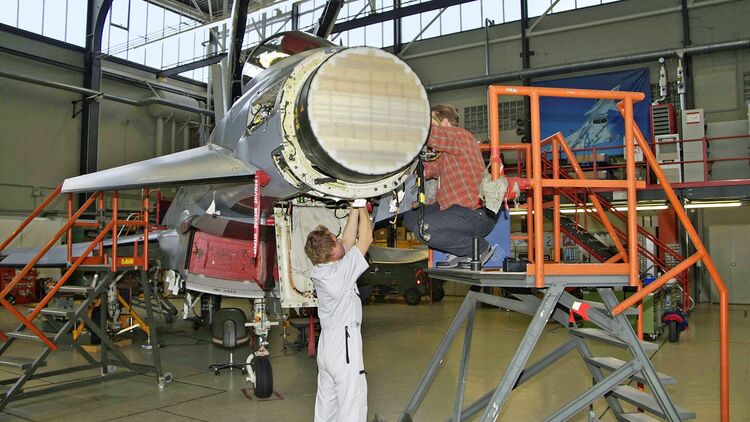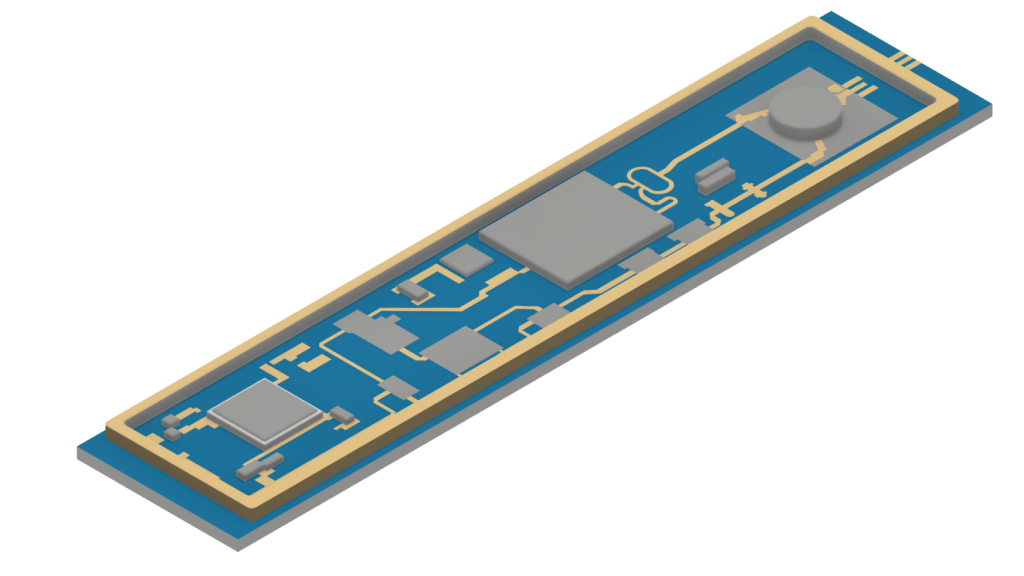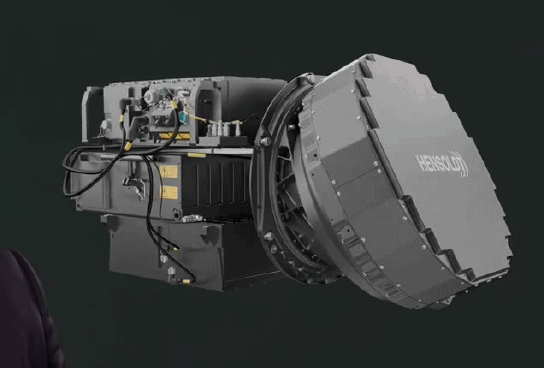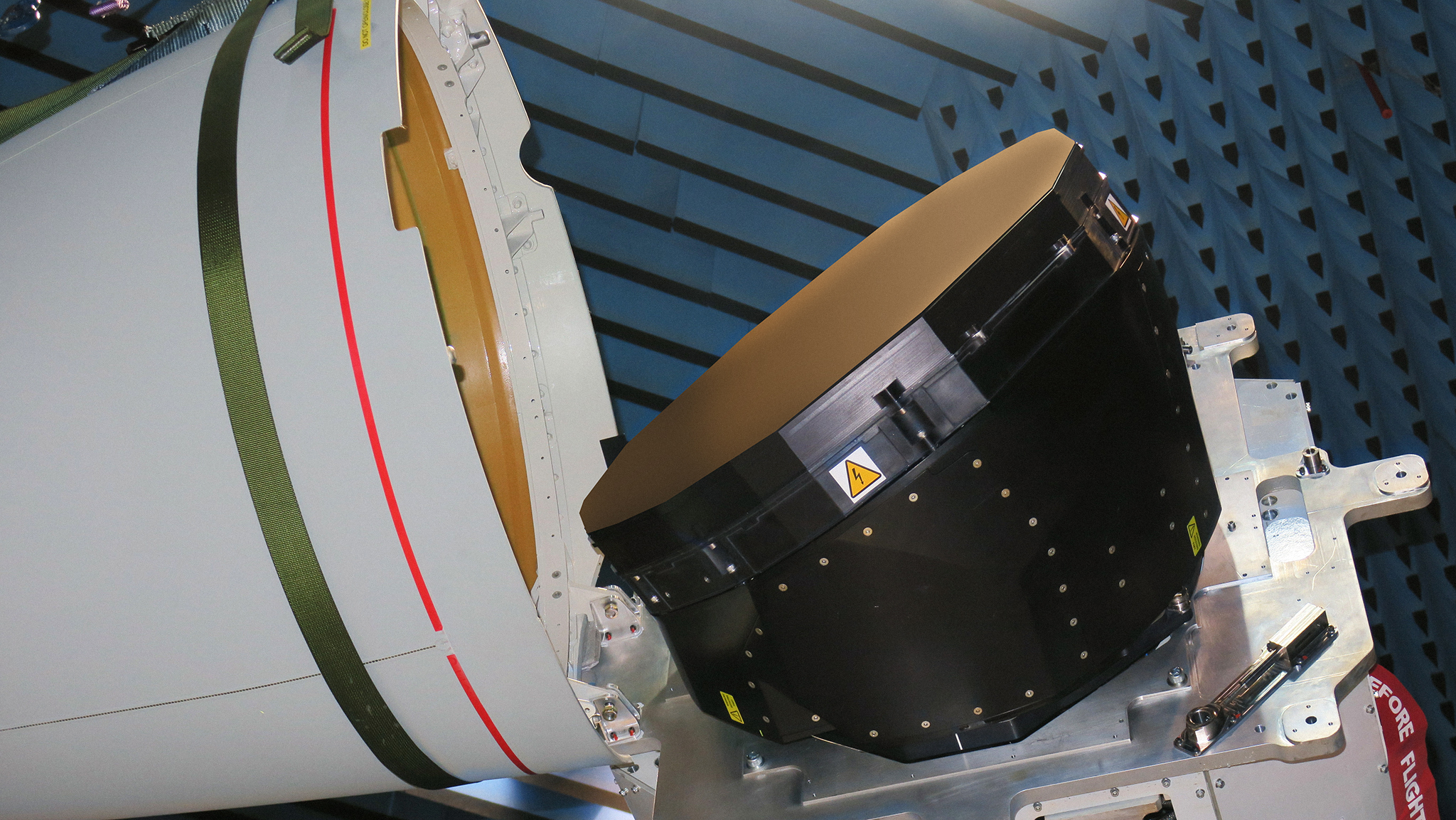The CAPTOR radar family provides the main sensor for the Eurofighter Typhoon fighter aircraft. This article gives a deeper insight into the AESA iterations: CAPTOR-E, ECRS Mk1 & ECRS Mk2. This is the second of a two-part series of articles. The first article focuses on the development and capability of the original mechanically steered CAPTOR versions. We recommend reading the previous article first.
Development Backround
AMSAR

As early as 1993, a European program for developing an AESA radar demonstrator for combat aircraft was initiated in the France and the United Kingdom, with Germany joining the effort two years later. Since then, a consortium comprising the companies EADS (now Hensoldt), Selex (now Leonardo) and Thales had been working on AMSAR (Airborne Multirole Solid State Active Array Radar), a generic demonstrator for developing the technology required for an AESA fighter radar. AMSAR had an array with a diameter of 60cm and was equipped with 1000 Gallium-Arsenide (GaAs)-based T/R (Transmit/Receive) modules.
The AMSAR programme’s objective was to produce an airborne AESA technology demonstrator with real-time operation, including the use of Adaptive Beam Forming (ABF) techniques. The target platforms for these new technologies were fast jet aircraft, in particular the Rafale and Eurofighter. The first purpose was to mature E-scan (Electronic scan) technology and demonstrate all operationally-significant attributes and functions of an AESA airborne radar. AMSAR focused on air-to-air performance, including Electronic Counter-Counter Measures (ECCM), and Ground Moving Target Indication (GMTI).
Integration and evaluation of the AESA antenna was carried out between 2005 and 2006 at EADS Defence Electronics in Germany. In 2006 and 2007 the entire radar system was integrated at EADS. The assembled radar was subsequently put through its paces in France against targets and jammers in a simulation environment, followed by ground trials against aerial targets and jammers. During this testing, the radar met or exceeded all required performance thresholds. The ground trials were followed by demonstrator flights, installed on the QinetiQ BAC 1-11 test bed aircraft. A total of 22 flights were performed in 2008 over land and sea in France, Germany, and the UK. The radar performance for air-to-air and air-to-ground modes was assessed against aerial targets (Tornado and Alpha Jet aircraft) and various ground objects. The technologies developed and the data gathered still form a significant basis of both the CAPTOR-E on the Eurofighter and the RBE-2 AA radar on the Rafale.
CAESAR

In addition to AMSAR, a number of government and industry funded technology programmes had been initiated in each of the four Eurofighter nations (United Kingdom, Germany, Italy and Spain) to develop and de-risk key elements of AESA technology including system concepts, processing algorithms and critical components. In 2002, a bilateral effort between the UK and Germany was initiated, named CECAR (CAPTOR E-Scan Risk Reduction). This project aimed to develop an AESA derivative of the existing CAPTOR radar, mounting a new AESA antenna front end to the existing CAPTOR-M back end whilst retaining the interface and some of the hardware of the original system in order to reduce risk and costs. Italy and Spain were also included later on in the program. After some progress with initial concept studies, the resulting radar was to be named CAESAR (CAPTOR AESA Radar).
The CAESAR system was fully integrated and tested in rooflab trials prior to being installed in the aforementioned BAC 1-11 test aircraft. Equal priority was given to robustness and performance to ensure that useful results could be obtained from the earliest flights. Compared to the AMSAR radar, there were substantial recorded performance increases. The improvement can be attributed to the new generation of T/R modules and the significantly larger antenna space available to the engineers, making it possible to integrate around 1500 T/R modules into the system. Significant effort was expended by all members of the Euroradar consortium to optimise the radar in order to satisfy the new objectives. Flight tests on a Eurofighter (Development Aircraft DA5) followed in the spring of 2007 in Germany. The bulk of this work was funded by the German MoD and supported by all Euroradar partners as an adjunct to the CECAR programme. These were focused on a set of functional modes of the CAPTOR system. In late 2007, the antenna was remounted on the BAC 1-11 to test advanced waveforms against air and ground targets. In 2008, the radar was primarily tested in Synthethic Aperture Radar (SAR) and simultaneous air-to-air and air-to-ground operations.
While CAESAR offered a low-risk path to upgrade all existing Eurofighters with an E-Scan antenna, historically low budgets and some of the radar’s insufficient performance metrics led to a failure for any nation to adopt the system. The technical concerns mainly revolved around the antenna being a vertically mounted, fixed aperture which would have resulted in an increase in Radar Cross Section (RCS) of the aircraft and lower detection performance at higher off-boresight angles.
CAPTOR-E
These complications delayed significant progress until November 2014, when a €1 billion development and integration contract was signed by the four core Eurofighter partners. The chosen radar standard now included a repositioner (as opposed to the fixed plate of CAESAR). The radar’s name now also was changed to CAPTOR-E. Final test flight campaigns in the following years were funded by Kuwait and Qatar, the first customers of the baseline CAPTOR-E Mk0 radar. The first series production radar sets were delivered to the Kuwait Air Force in late 2021.
Hardware Architecture
In order to manage cost and risks associated with an E-Scan upgrade for the CAPTOR radar, the baseline CAPTOR-E Mk0 retains a significant portion of the original hardware. Both the radar processor and multi channel receiver are kept with slightly modified software.

Transmit/Receive-Module

Fighter radar AESA antennas are assembled with hundreds, or even thousands, of T/R modules. The CAPTOR-E radar makes use of modified Hensoldt Standardized Modular Transmit/Receive (SMTR) modules. The T/R modules are being dual-sourced from both the UK and Germany. SMTR was the result of a development with particular effort into maximising cost-effectiveness with regards to materials, processes and production constraints with efforts starting in the year 2000. The module covers core requirements for various applications such as fighter radars, surveillance radars or for advanced spaceborne SAR satellite systems (TerraSAR-X).
The T/R module’s components are housed on a hermetically sealed PCB. The compact dimensions of 64.5 x 13.5 x 4.5mm result in a weight of less than 15 grams. On the PCB there is an integrated circuit (ASIC) composed of a GaAs-based high power amplifier (HPA), circulator, limiter, Low Noise Amplifier (LNA), phase controller, amplifier controller and a circulator. Due its compact design, the power losses during signal processing are very low. However, air cooling is no longer sufficient for these devices and thus the T/R modules are liquid-cooled.
The module covers frequencies from 8GHz to 11GHz (X-Band). A power of up to 39dBm (8W) can be delivered at the output. Relatively low power consumption leads to an overall efficiency of more than 20%. The typical noise figure of the complete module amounts to <3.0dB over the entire frequency range.
Antenna Assembly

The E-Scan Antenna is mounted on a repositioner that allows a wide field-of-regard (WFoR) in terms of angular coverage (azimuth) compared to a fixed-plate antenna. Traditional fixed-plate phased array radars are roughly limited to a +-60° scan area, whereas this setup allows for surveillance and detection at an angular coverage of around +-90° degrees. This is achieved by the use of Leonardo- and Airbus-developed swashplates. The repositioner features two coupled swashplates which can also change the radar’s elevation from -30° to +30° degrees. It should be noted the repostioner adapts its movement pattern and location based on the currently selected radar mode.
With it’s comparatively large diameter, the antenna is designed to house around 1500 T/R modules which are screwed into the liquid cooling interface.
The antenna assembly also houses all relevant connections between the radar’s frontend and backend. It houses all cables and the tubing of the radar’s liquid cooling circuit, which is routed through the entire backplate of the antenna.
Further development
Due to differing capability requirements, the core nations of the Eurofighter project decided to opt for more advanced radar systems to be fielded for their fleets. Unlike previous projects within the multilateral program, there is now a split in the respective development efforts.
Germany and Spain have initiated a cooperation for a further upgrade of the radar, dubbed European Common Radar System (ECRS) Mk1, whilst the United Kingdom has chosen a different development route via the ECRS Mk2 program.
ECRS Mk1
Collaborating with Indra, Hensoldt is leading the project for an upgraded AESA radar for the Eurofighter Typhoon, incorporating components from the baseline CAPTOR-E Mk0. The projected started in 2020 after the German and Spanish government approved funds totalling €1.5 billions, covering development, integration and delivery to retrofit the entire fleet of Tranche 2/3 Luftwaffe Eurofighters and an initial 5 Spanish Air Force aircraft.

The following Luftwaffe Quadriga (38 aircraft) and Spanish Halcon I (20 aircraft) Eurofighters were later also contracted with Mk1 radars. The planned Halcon II procurement will likely result in an order of an additional 25 airframes, raising the number of orders to approximately 200 radar sets.
Besides Hensoldt and Indra the original consortium partner Leonardo is also involved in the project, mainly dealing with supplying legacy components from the Mk0 radar such as the radar processor and modified components of the antenna power supply & control unit.
One of the main hardware changes compared to existing Mk0 radars are new Gallium-Nitride (GaN) based wideband T/R modules. The introduction of new T/R modules was necessitated by the Luftwaffe’s requirements for longer detection ranges and UHR SAR imagery with 10cm resolution.
The other major hardware development is the introduction of a digital multi-channel receiver. Compared to the old (partly analog) 3 channel receiver with PowerPC processors, the new receiver is fully digital and makes use of modern multi-core processors. The new hardware greatly improves the radar’s electronic countermeasure (ECM) resistance. Additionally the added data capacity also opens up possibilities for the introduction of Electronic Attack (EA) and other non-traditional radar features.
In 2022 problems arose for the project as the German authorities failed to certify the new multi-core processors with existing certification processes, which resulted in delays and cost-overrun. In the same year the decision was made to adapt the Eurofighter for the Electronic Combat and Reconaissance (ECR) mission role, which led to additional Electronic Warfare features being required for the Mk1 radars. This resulted in a follow-up contract worth €200 million in late 2023, covering the additional expenses.
The program is structured to have a 2-phase maturation stage, with the radars initially being delivered in a ‘Step 1’ configuration, featuring the new T/R modules and the digital receiver. The software will also be brought to a new standard compared to existing Mk0 updates. The ‘Step 2’ improvement is planned to be fielded by 2028. The objective is to revamp the software and task architecture while also modernize the radar processor, doubling the amount of radar features. The upgrade will introduce new offensive Electronic Warfare capabilities and improve the performance of existing modes. After the upgrade developers and engineers will also have the possibility of remotely updating the radar’s software.
Current plans foresee the first Mk1 radar sets to be fielded with the delivery of the first Luftwaffe Tranche 4 (Quadriga) aircraft in 2025.
ECRS Mk2
Since the initial development of the baseline Mk0 CAPTOR-E, the British Royal Air Force (RAF) had placed a particular emphasis on the future role of Electronic Attack within the mission spectrum of the Eurofighter’s AESA radar.
The first development contract valued at £317 million was awarded in September 2020. A follow on £870 million contract was signed in July 2023, covering further development work and the production of 12 radar sets. Instead of opting for a fleet wide upgrade, the British MoD has limited the scope of ECRS Mk2 retrofits to it’s 40 Tranche 3 Typhoons.
Unlike the ECRS Mk1 the Mk2 radar shares more features with Leonardo’s Vixen 1000E/ES-05 radar, rather than the Mk0 AESA. The remaining commonalities are the Antenna Power Supply & Control system, the cooling architecture and the interface to the Eurofighter’s attack computer.

Like the ES-05, the Mk2 radar also uses a single rotational joint mechanism to retain the WFoR capability introduced with the original CAPTOR-E. The antenna houses newly developed T/R modules making use of both GaAs and GaN technology.
The open architecture backend of the ECRS Mk2 features a new processor and receiver based on previous Leonardo products, along with a dedicated EW receiver and techniques generator.
The open architecture of the radar system is designed to facilitate short development cycles, allowing for quick adaptations. The idea is to modularize the hardware and software to make upgrading the radar equivalent in simplicity to altering mission data. Importantly, this can be accomplished without the need to revisit the safety case whenever software changes are made.
Additionally to the new radar Meggitt has been awarded a development contract for a new radome design allowing for a broader transmission bandwidth needed for new Electronic Warfare functions.
After a significant testing phase at both Leonardo and BAE facilities in the UK, Leonardo delivered the first radar system to BAE for integration on a Typhoon in November 2023. With the first flight delayed from 2023 to 2024, the planned IOC for the RAF Typhoons equipped with ECRS Mk2 is now stated to be 2030.
